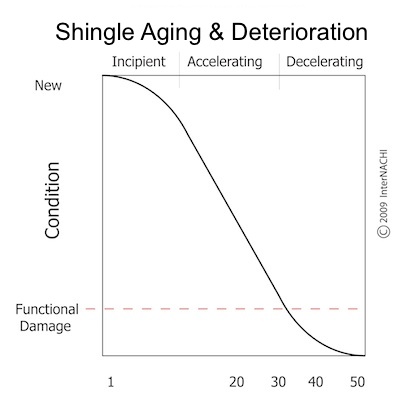The following factors affect the lifespan of an asphalt composition shingle roof:
- roofing material quality;
- quality of maintenance;
- proper installation;
- number of layers;
- structure orientation: south-facing roofs will have shorter lifespans;
- degree of roof slope: flatter roofs will have shorter lifespans;
- climate and exposure: (wind, hail, snow & rain); Harsh climates shorten roof lifespans;
- homesite location: wind damage, flashing corrosion;
- temperature swings: climates with large daily temperature differentials will shorten roof lifespans;
- elevation: homes at higher elevations are exposed to more ultra violet (UV) light, which shortens roof lifespan;
- roof color: darker roofs absorb more heat which may shorten roofing material lifespan;
- roof structure ventilation: Poor ventilation shortens roof lifespans;
- physical abrasion: avoid walking on the roof as much as possible, especially on very hot or very cold days when shingles may be especially soft or brittle; and
- freeze/thaw cycles: areas of the roof where snow collects or ice dams accumulate are subject to damage from leakage, or from efforts to remove ice dams.

Learn more about factors affecting shingle aging rates and premature shingle failure from InterNACHI's Mastering Roof Inspection series at:
